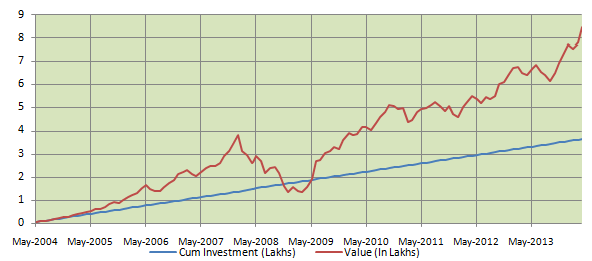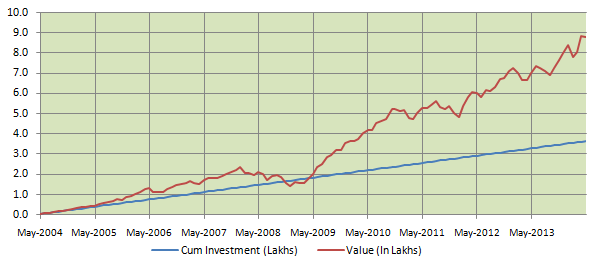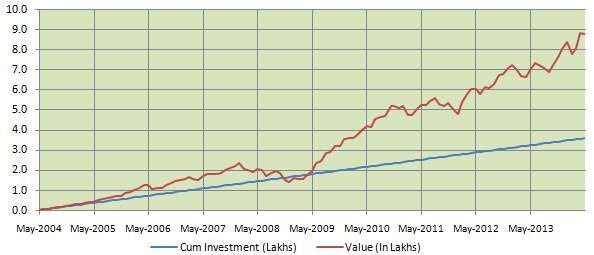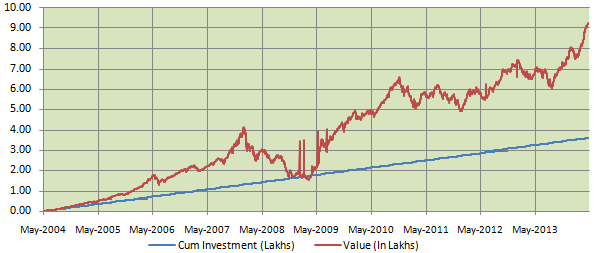Mutual Fund SIPs have created wealth over the last 10 years: Small and Midcap funds

In our previous article,How Mutual Fund SIPs have created wealth over the last 15 years: Large Cap and Diversified Equity, we had discussed how Systematic Investment Plans (SIPs) in good large cap and diversified equity funds created wealth for the investors in the last 15 years. In this article, we will discuss, how small and midcap funds have created wealth for the investors in the last 10 years. Small and midcap funds are inherently more risky than large cap and diversified equity funds, but they have the potential to generate higher returns, since midcap companies generally have higher growth potential compared to large cap companies. However, investors should also note that small and midcap funds are more volatile and they get punished more than large cap and diversified equity funds in a bear market. Therefore, only investors with appetite for high risk should go for such funds. Small and midcap funds should form a small part of your portfolio since they can give good returns, even when the valuations of large cap stocks seem a little expensive. Large cap funds outperform midcap funds in some market conditions, while midcap funds outperform large cap funds in some market conditions, and therefore it makes sense to have a mix of large cap, diversified equity and small & midcap funds in your mutual fund portfolio. As discussed in the previous article in this series, Systematic Investment Plans can turn market volatility into an advantage for the investors, by averaging the cost of the investment. This works very well for small and midcap funds, which are inherently more volatile than large cap and diversified equity funds.
In this article, we will discuss how SIPs in some small & midcap funds, have created wealth for their investors. For our discussion, we have selected 5 small & midcap that have given good returns in the last 10 years. This is, by no means, a comprehensive list of all the small and midcap funds that gave good returns in the last 10 years. This just an illustration of how long term investments in SIPs, have created wealth for investors in small and midcap funds. Each of the funds in our selection has given compounded annual SIP returns of nearly 15% or more, over the last 10 years. Since SIP investments are made over a period of time, the method of calculating SIP returns is different from that of Lump Sum investments. SIP returns are calculated by a methodology called XIRR, which is a variant of Internal Rate of Return (IRR). XIRR is similar to IRR, except XIRR can calculate returns on investments that are not necessarily strictly periodic.
For our examples, we have assumed a monthly SIP of Rs 3000 only, made on first working day of every month in the small and mid cap funds that we will discuss. Let us assume the SIP start date was 10 years back in May 2004. Over this period, the investor would have invested Rs 3.6 lakhs in SIPs of the following mutual funds. Let us see how much wealth would they have accumulated, by investing in the following funds.
SBI Magnum Global Fund:
The SBI Magnum Global fund, is one of the oldest small and midcap funds. The fund was launched in Sep 1994 and will complete 20 years in a few months. The fund has an AUM base of over Rs 910 crores and is managed by R.Srinivasan. The chart below shows the SIP returns of the SBI Magnum Global fund, growth option, over the last 10 years.Birla Sun Life Midcap Fund:
The Birla Sun Life Midcap Fund was launched in January 2002. The fund has an AUM base of over Rs 950 crores and is managed by Nishit Dholakia. The chart below shows the SIP returns of the Birla Sun Life Midcap Fund, growth option, over the last 10 years.Franklin India Prima Fund:
The Franklin India Prima fund, a small and mid cap fund launched in 1993, has for long been a favourite with investors. The fund has an AUM base of over Rs 950 crores and is managed by R.Janakiraman. For the detailed fund review of Franklin India Prima Fund, please visit our article, Consistent mid cap picker for last 20 years. The chart below shows the SIP returns of the Franklin India Prima fund, growth option, over the last 10 years.Birla Sun Life MNC Fund:
The Birla Sun MNC fund is a small and midcap fund launched in December 1999. This fund from the Birla Sun Life stable has an AUM base of over Rs 430 crores and is managed by Ajay Garg. The chart below shows the SIP returns of the Birla Sun Life MNC fund, growth option, over the last 10 years.Sundaram Select Midcap Fund:
The Sundaram Select Midcap fund is a small and midcap fund launched in July 2002. This fund, which is also one of the best performing small and midcap funds ever, has an AUM base of nearly Rs 1660 crores and is managed by S.Krishnakumar. For the detailed fund review of Sundaram Select Midcap fund, please visit our article, Good track record makes this mid cap fund a worthwhile consideration. The chart below shows the SIP returns of the Sundaram Select Midcap fund, growth option, over the last 10 years.

If you had started a monthly SIP of Rs 3000 in SBI Magnum Global fund back in May 2004, by now you would have accumulated nearly Rs 9 lakhs corpus, with an investment of only Rs 3.6 lakhs. You would have accumulated corpus of Rs 5 lakhs by the end of 2010, despite the severe financial crisis in 2008 and again the market downturn in 2011. Over the 10 year period the compounded annual tax free returns on your SIP investment in this fund would be 16.3%.

If you had started a monthly SIP of Rs 3000 only Birla Sun Life Midcap Fund back in May 2004, by now you would have accumulated a corpus of nearly Rs 8 lakhs, with an investment of only Rs 3.6 lakhs. You would have accumulated corpus of Rs 5 lakhs by the end of 2011 and beginning of 2012, despite the severe financial crisis in 2008 and again the market downturn in 2011. Over the 10 year period from 2004 to 2014, the compounded annual tax free returns on your SIP investment in this fund would be 14.2%.

If you had started a monthly SIP of Rs 3000 only in Franklin India Prima fund back in May 2004, by now you would have accumulated a corpus of nearly Rs 8 lakhs, with an investment of only Rs 3.6 lakhs. You would have accumulated corpus of Rs 5 lakhs by the end of 2012, despite the severe financial crisis in 2008 and again the market downturn in 2011. Over the 10 year period from 2004 to 2014, the compounded annual tax free returns on your SIP investment in this fund would be 14.6%.

If you had started a monthly SIP of Rs 3000 only in the Birla Sun MNC fund back in May 2004, by now you would have accumulated a corpus of over Rs 8.8 lakhs, with an investment of only Rs 3.6 lakhs. You would have accumulated corpus of Rs 5 lakhs by the end of 2011, despite the severe financial crisis in 2008 and again the market downturn in 2011. Over the 10 year period the compounded annual tax free returns on your SIP investment in this fund would be nearly 17%.

If you had started a monthly SIP of Rs 3000 only in the Sundaram Select Midcap fund back in May 2004, by now you would have accumulated a corpus of nearly Rs 9.2 lakhs, with an investment of only Rs 3.6 lakhs. You would have accumulated corpus of Rs 5 lakhs by the end of 2010, despite the severe financial crisis in 2008 and again the market downturn in 2011. Over the 10 year period the compounded annual returns on your SIP investment in this fund would be nearly 18%.
Conclusion
In this article, we have seen how SIPs in small and midcap funds over the long term have created wealth for the investors. SIPs benefit from the power of compounding, and therefore the earlier we start our SIP, the greater is the potential for wealth creation. However, given that small and midcap funds are inherently carry higher risks, it is important to select a good small and midcap fund for our SIPs. As good financial planners will suggest, you should have a portion of your investments in small and midcap funds, to create a good portfolio of mutual funds. Your financial advisers can help you select a good small and midcap fund that is suitable for your risk profile. As your risk profile changes over time, you should re-balance your portfolio to align with your risk profile. Tomorrow, we will discuss how SIPs in ELSS funds have created wealth for the investors.
Queries
-
What is the benefit of mutual fund STP
Aug 29, 2019
-
How much to invest to meet target amount of Rs 2 Crores
Aug 26, 2019
-
Can I achieve my financial goals with my current mutual fund investments
Aug 24, 2019
-
Can you tell me return of various indices
Aug 19, 2019
-
What would be the post tax return on different investments
Aug 18, 2019
-
Which Principal Mutual Fund scheme will be suitable for my retirement corpus
Aug 16, 2019
-
What is the minimum holding period for availing NCD interest
Aug 4, 2019
Top Performing Mutual Funds
Recommended Reading
Fund News
-
Kotak Mahindra Mutual Fund launches Kotak Energy Opportunities Fund
Apr 3, 2025 by Advisorkhoj Team
-
Groww Mutual Fund launches Groww Nifty 500 Momentum 50 ETF FOF
Apr 3, 2025 by Advisorkhoj Team
-
Groww Mutual Fund launches Groww Nifty 500 Momentum 50 ETF
Apr 3, 2025 by Advisorkhoj Team
-
ICICI Prudential Mutual Fund launches ICICI Prudential Nifty EV and New Age Automotive ETF FOF
Mar 28, 2025 by Advisorkhoj Team
-
UTI Mutual Fund launches UTI Income Plus Arbitrage Active Fund of Fund
Mar 21, 2025 by Advisorkhoj Team













